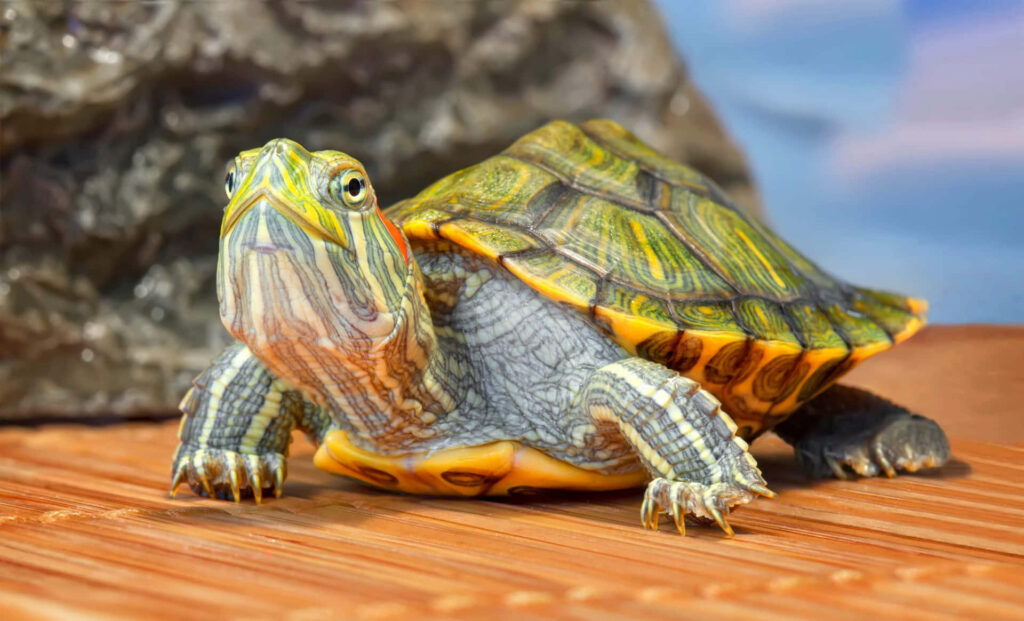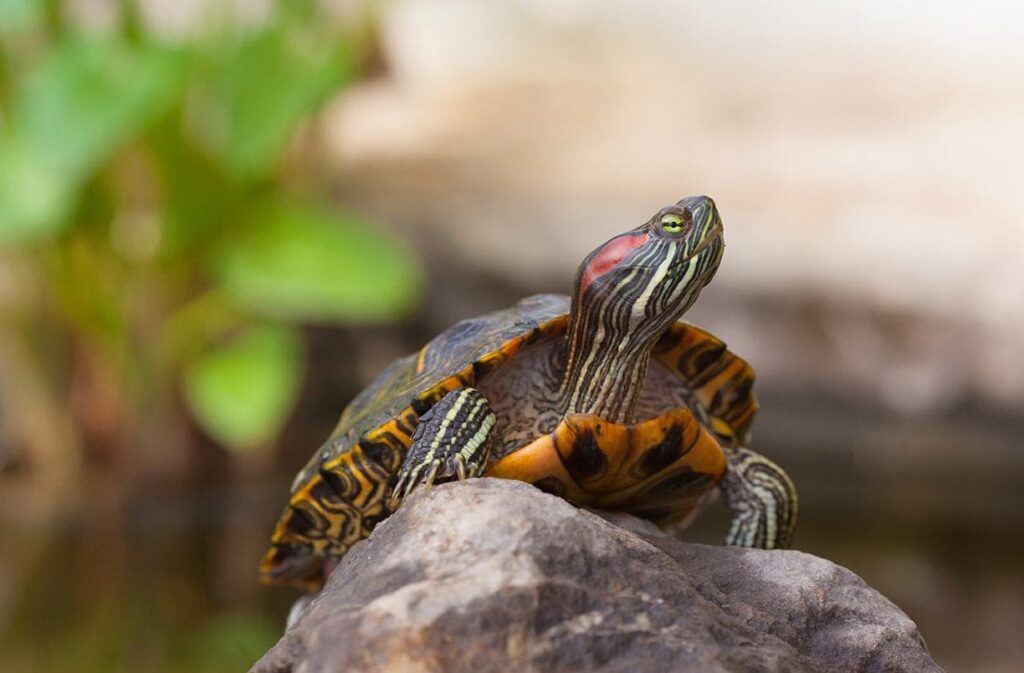Table of Contents
ToggleIntroduction

Few creatures rival the charm and charisma of the red-eared slider turtle (Trachemys scripta elegans) in the intriguing domain of aquatic companionship. What Do Red-Eared Slider Turtles Eat? These vivid reptiles from the southern United States have become popular pets worldwide, enthralling fans with their distinctive red markings and engaging personalities. Understanding these wonderful creatures’ food demands is a critical duty for keepers as they embark on the rewarding adventure of caring for them.
Red-eared slider turtles’ eating habits are as varied as the ecosystems they inhabit. As omnivores, these turtles demonstrate an intriguing mix of herbivorous and carnivorous tendencies. Making their nutrition a fascinating subject for novice and veteran turtle fans.
Analysis Of Typical Wild Diet
Plants and Vegetation: Red-eared slider turtles are predominantly herbivores in the wild. Showcasing a penchant for various aquatic plants and vegetation. The lush vegetation along the water’s edge is a significant component of their diet. Aquatic plants such as water lettuce, water hyacinth, and various submerged plants contribute to the nutritional balance required for their well-being. The consumption of these plant materials not only provides essential nutrients but also aids in maintaining the turtles’ overall digestive health.
Insects and Aquatic Animals: Despite their herbivorous tendencies, red-eared sliders also display an opportunistic carnivorous side. Incorporating insects and small aquatic animals into their diet. Insects like dragonflies, beetles, and caterpillars are enticing prey, offering a protein-rich supplement to their primarily plant-based nutrition. In their habitat, small fish, tadpoles, and crustaceans contribute essential proteins, fats, and minerals to support the turtles’ growth and vitality.
Captive Diet
The key to sustaining red-eared slider turtle health and vitality in captivity is to replicate the richness and diversity of their natural diet. Although the confined environment differs from the wild. A well-crafted diet can bridge the gap by supplying the vital nutrients these turtles require for optimal well-being.
Natural Diet Replication in Captivity: Captive keepers should prioritize combining plant-based and protein-rich food sources to mimic. The diversified diet of red-eared slider turtles in their natural habitat. Offering a range of leafy greens like romaine lettuce, kale, and spinach mimics the vegetation found in their native habitat. Incorporating aquatic plants such as water hyacinth and duckweed also provides nutritional diversity to their diet.
For the carnivorous portion of their diet, offering live or commercially available insects such as crickets and mealworms ensures they get the necessary proteins and fats for growth and development. Small fish, shrimp, and earthworms can get the goods as supplements to simulate the diversity of their natural diet.
Red-Eared Slider Turtle Diet
Essential Vitamins and Nutrients: Like their wild counterparts, captive red-eared slider turtles require a well-balanced mix of vitamins and nutrients to survive. Vitamin D is very important for shell health, and UVB light exposure is needed to aid calcium absorption. Commercial turtle pellets supplemented with vitamins and minerals are a convenient and complete source of nutrition. Calcium supplements can help turtles get the building blocks they need to have strong and healthy shells.
Balanced Protein, Fat, and Carbohydrates: Achieving the proper protein, fat, and carbohydrate balance is critical in duplicating the dietary needs of the red-eared slider turtle. While protein is necessary for growth and muscular development. It is important not to overestimate its importance because too much protein can cause health problems. A well-balanced commercial turtle food, supplemented with protein-rich treats occasionally, achieves a harmonious balance. In addition, eating a variety of vegetables and fruits gives vital carbs for energy.
Choosing High-Quality Pellets
Ingredient Analysis: The chemicals employed in formulating a high-grade commercial turtle pellet constitute the basis of its quality. A thorough examination of the ingredient list is required. Look for pellets that contain complete proteins, such as fish meal or shrimp, as their principal protein source. Various plant nutrients, such as spirulina and alfalfa, can help maintain a healthy diet.
It is best to avoid pellets that rely significantly on fillers and artificial additives. High-quality pellets favor natural, nutrient-rich ingredients over unnecessary preservatives or artificial colors. The absence of low-nutrient fillers ensures that each pellet contains. The essential nutrients required for the overall health of red-eared slider turtles.
Nutrition: The nutritional composition of commercial turtle pellets is an important factor in their effectiveness. A well-balanced pellet should contain various essential vitamins and minerals. Including vitamin D3, for calcium absorption, which is critical for shell health. Adequate protein intake from various animal and plant sources aids turtle growth and muscle development.
Please pay attention to the fat content and ensure it corresponds to the normal dietary requirements of red-eared sliders. Obesity can be caused by eating too much fat while eating too little can decrease energy levels. Carbohydrates derived from grains and vegetables add to overall energy requirements.
Eating A Range Of Foods
Why a Variety of Food Is Important: Variety is the Spice of Life, and the same is true for red-eared slider turtles’ food needs. It is very important for animals in the wild and captivity to eat various foods. Giving these interesting snakes a wide range of foods mimics how they normally eat and ensures they get all the nutrients they need. This part talks about how important it is for red-eared slider turtles to eat various foods.
Options That Are Safe and Good for You: Red-eared slider turtles get important vitamins, minerals, and fiber from fresh vegetables and fruits, which makes their food more nutritious. Choose leafy greens like dandelion greens, collard greens, and mustard greens. These are high in calcium and other important nutrients. Carrots and bell peppers are two colorful veggies that make their meals more interesting to look at.
Offering: Turtles should eat commercial pellets as their main food source. But People should present themselves with fresh fruits and vegetables. To them occasionally. A healthy and varied diet is important, so share these treats weekly. Because they are high in sugar, Too much produce can be harmful. You can change how often and what kinds of fresh foods you give your turtle by carefully watching their behavior and monitoring their general health.
Conclusion
The intricate tapestry of a red-eared slider turtle’s nutritional choices has unraveled a riveting narrative that spans the lush landscapes of their native habitats and our meticulously manicured captive surroundings. The meal of the red-eared slider exhibits a sophisticated balance between herbivory and carnivory. From the vivid array of plants surrounding the water’s edge to the opportunistic feasts on insects and aquatic delights.
We’ve discovered the art of duplicating their natural diet while navigating the waters of captive care — a delicate tango between commercial turtle pellets rich in key nutrients and the verdant tapestry of fresh veggies and fruits. The meticulous selection of high-quality pellets, with a sharp eye on components and nutritional value, offers a foundation of health and energy for these attractive reptiles.







